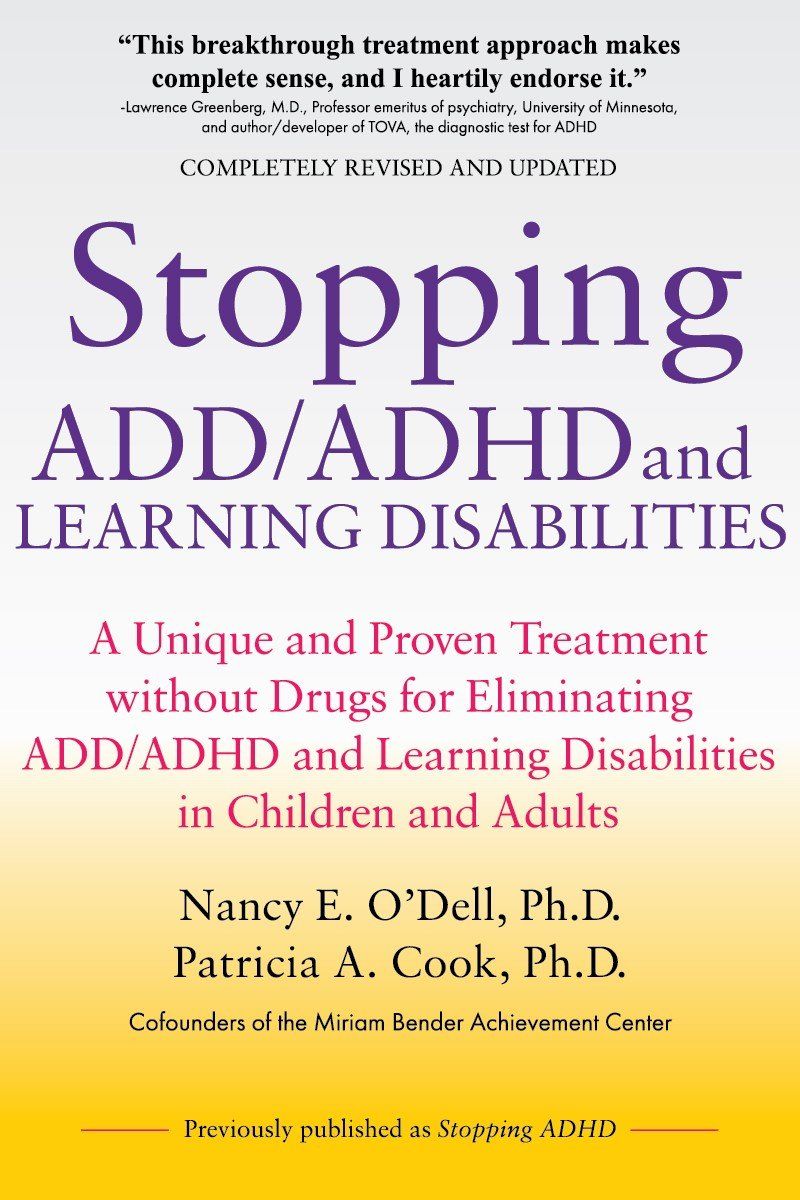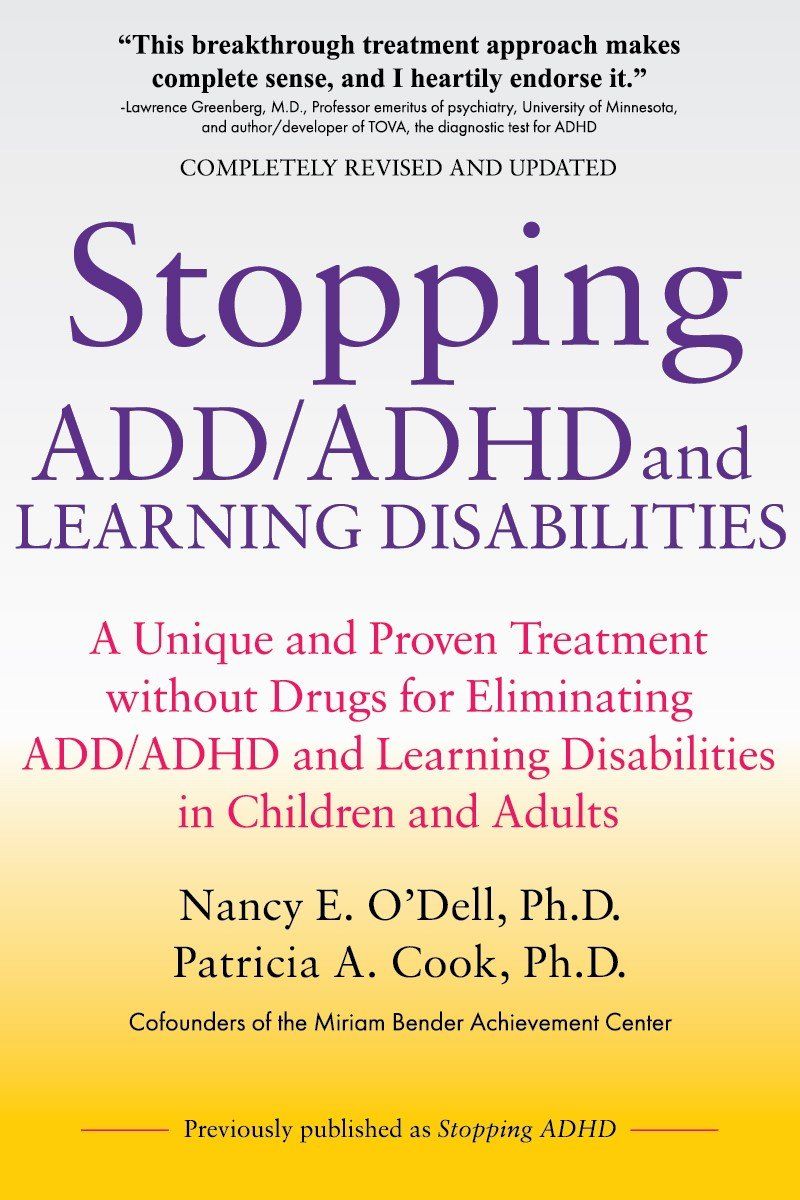Stopping ADD/ADHD and Learning Disabilities
Unique Drug-Free Program
Drug Free Solution | For Children & Adults
You've Never Seen Data on ADD/ADHD Like This Before
"Stopping ADD/ADHD and Learning Disabilities" by Nancy E O'Dell and Patricia A. Cook, Ph.D has a wealth of information on the scientific study of attention deficit hyperactivity disorder.
- Book Only- $19.95
- DVD only- $29.95
- Combo Package - $39.95 for book and DVD
Book Summary One
Part One - What is the Real Problem?
Does your child or anyone you know display the following behaviors?
- Squirming
- Getting up frequently
- Losing attention quickly
- Daydreaming frequently
- Writing poorly
- Writing laboriously
- Reversing letters or numbers
- Moving awkwardly or clumsily
- Avoiding athletics
- Developing athletic skills slowly
- LD individuals
If the answer is, "Yes," and your child has been labeled hyperactive or as having attention-deficit disorder (ADD/ADHD) or any other learning disability, we think you will find this book of great interest. Within it, we present compelling evidence that effectively challenges the current medical diagnosis and treatment of hyperactivity, ADD/ADHD, and many other behavioral and learning problems. If you have found that your life is dominated by the constant disruptive behavior of a child, we will provide you with a simple, logical, and accurate explanation of the real causes of this behavior, and we will offer you effective methods to eliminate behavior problems without the use of drugs.
Chapter 1: The Real Problem
Many children seem unable to sit still or function normally in school, home, and community situations where controlled behavior is expected. Parents of these children may find that their lives are dominated by the child's constant disruptive behavior. Frequently, these children are labeled hyperactive or described as having attention-deficit disorder (ADD/ADHD) or some other learning disability. There is a simple, logical, and accurate explanation of the real cause of this behavior: these children are extremely uncomfortable, and their extreme discomfort has a real, physical basis.
Chapter 2: The Symmetric Tonic Neck Reflex
Just what is this reflex that makes children so uncomfortable by pulling their bodies in two different directions? Knowing what the reflex is will help you to understand better how it may affect your children. The cure for the problem will make more sense if you understand the cause of the problem. To explain that cause, we will first review the early stages of child development. The Symmetric Tonic Neck Reflex (STNR) is supposed to be in control of a baby's body at the age of six months. The STNR helps a baby pull into a crawling position by straightening the baby's neck and arms while simultaneously bending the baby's legs. The STNR makes the top half of the body work opposite from the bottom half. But this reflex should not be in control of the child's body after the age of two years. If a baby does not crawl properly and for at least six months, the STNR will remain somewhat in control (immature) and can cause problems later on. When a child goes to school, an immature STNR can significantly interfere with the child's ability to sit still, pay attention, and write easily.
** All new, very important information on the unexpected negative results from putting babies on their backs too much.
Chapter 3: Looking for Clues to the Real Problem
Because of the frustration, aggression, and inflexibility that STNR children often display, many of them are misdiagnosed as having primary emotional problems that are causing their academic and behavioral difficulties. We are convinced that it is usually the other way around! Academic failure causes the emotional distress. Because of an immature STNR, most of these children fail to meet academic and behavioral demands. In many cases, the academic and behavioral problems are primary; the emotional problems are secondary, an emotional overlay. Postural clues-the way a child sits or doesn't sit-can be obvious indications of an immature STNR.
Chapter 4: Psychological Consequences of the STNR
Our clinical experience has convinced us that most STNR children do not have primary psychological problems. However, many of them do suffer psychological consequences caused by the interference of the STNR and by the misdiagnosis and mistreatment of the real problem - the STNR. An immature STNR can cause a child to exhibit the behaviors of hyperactive children, and it can affect the child's school performance. Although basic intelligence is not affected by the immature STNR, the STNR child's extreme discomfort in many school situations - particularly the appropriate sitting position - can interfere with academic performance. Maturing the STNR through therapeutic exercises can allow the child to function normally.
Book Summary Two
Part Two - How to Work Around the Real Problem
If, through your detective work, you have determined that someone you know (yourself, your child, or your spouse, for example) has an immature STNR, there are two ways of dealing with the problem: circumventions and interventions.
Circumventions: methods for working around a problem.
Interventions: methods for working through a problem, actually solving it.
In general, interventions are obviously more desirable than circumventions. We truly thank God that, because of Dr. Miriam Bender's work (see the discussions in the preface and introduction), interventions are available for maturing the STNR. However, interventions require several months to implement. Consequently, we will first discuss circumventions, which you can begin even as you read this chapter, and which you can continue as you provide interventions for an immature STNR.
Chapter 5: School Problems
How does an immature STNR interfere with school work? We find that many children are not doing well in school simply because they don't do their writing assignments well (or at all). It has been our experience that many children having difficulties in school do not have basic difficulties understanding the material. Their basic problems are with sitting still, maintaining attention, and writing - all hampered by the immature STNR.
Below are examples of a child's papers before and after implementation of the STNR exercises.
Chapter 6: Sports Problems
How does the immature STNR interfere with sports? An immature STNR can be directly responsible for poor motor coordination (resulting in clumsiness or awkwardness). Poor coordination usually contributes to poor performance in athletics. Poor performance usually limits participation. Limited participation, in turn, prolongs poor performance. It becomes a vicious cycle.
An immature STNR usually affects children's athletic performance in one of two ways. Generally, these children do very poorly in most sports. However, some STNR children may do fairly well in certain sports. Either they work ten times harder than other children to achieve some success, or the immature STNR does not interfere with the body position required for success in that particular sport.
Your child may seem well coordinated, but only in certain sports. The interference of the reflex can be very tricky. The immature reflex causes the top half of the body to want to do the opposite from the bottom half. It is very difficult for STNR children to have their bodies either all straight or all bent at the same time.
For example, it is very difficult for STNR children to run and catch at the same time. They have trouble looking up in the air and following the ball without stumbling or falling to the ground. Remember, as the neck and arms straighten, the immature STNR makes the knees want to bend. There really are no circumventions for STNR children in sports. The most helpful approach is to recognize the symptoms of the immature reflex and steer the child into specific sports and positions that will not be negatively affected by an immature STNR.
Chapter 7: Problems at Home
How does the immature STNR cause problems at home? What is it like living with STNR children? Is it fun? Is it fun to have dinner, watch television, or try to read the paper next to a child in constant motion? Is it fun to try to help STNR children with their homework? Usually, it is not much fun at all. The therapy described in Part Three of this book can change that situation, but in the meantime the circumventions in this chapter can make life much more pleasant for the parent and child.
Chapter 8: Problems in Public Settings
How does the immature STNR cause problems outside the school or home, in the wider community? The grief that STNR children experience and cause at home is intensified when they go out in public. Generally speaking, parents and society expect children to display better behavior in public than is required of them at home. STNR children can be disruptive because of the discomfort that the immature reflex causes them. Because of the effects of the STNR on their behavior in public, children are often accused of being poorly disciplined when, in fact, they are just extremely uncomfortable.
The circumventions described in this chapter can make the child more comfortable in public situations - which, in turn, will make the child more welcome in those situations.
Schedule An Appointment Today!




